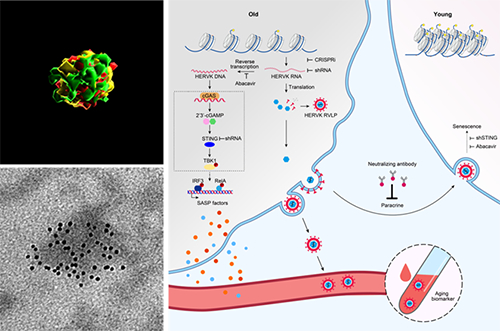
Figure. The molecular mechanism and intervention strategy of senescence driven by resurrection of endogenous retroviruses
Supported by the National Natural Science Foundation of China (Grant No. 81921006, 82125011, 92149301, 92168201, 91949209 and 92049116), the research group led by Prof. Guanghui Liu and Prof. Jing Qu from the Institute of Zoology of the Chinese Academy of Sciences together with Prof. Weiqi Zhang’s research team from the Beijing Institute of Genomics of the Chinese Academy of Sciences have made progress in revealing the molecular mechanism and intervention strategy of aging. The research results were published online in Cell on January 6, 2023 titled “Resurrection of endogenous retroviruses during aging reinforces senescence”.
Article link: http://doi.org/10.1016/j.cell.2022.12.017
The co-option between viruses and humans plays important role during human evolution. Endogenous retroviruses (ERVs) are a relic of ancient retroviral infection, fixed in the genome during evolution, comprising about 8% of the human genome. During the late stage of embryonic development, most human ERVs (HERVs) are strictly repressed by host mechanisms such as epigenetic regulation.
Cellular senescence is an important hallmark of aging and aging-related diseases. However, it’s largely unknown whether endogenous retroviruses dormant in the human genome can escape host surveillance during the aging process and become awakened. If so, what role does ERV play in senescence and what’s the mechanism behind? Can EVR serve as a target to evaluate and intervene in aging-related diseases? These key scientific questions remained unclear.
Using various aging models and multiple technologies (including multidimensional epigenome, transcription-targeted regulation, single-molecule imaging, virology, immunology, chemical biology and molecular pathology), the research team has found that epigenetic derepression leads to transcriptional activation of ERV, thereby increasing the translation of viral proteins, as well as the accumulation of viral-like particles (RVLPs) in senescent cells. The reverse transcripts of ERVs activate the cGAS-STING-mediated innate immune pathway, thereby eliciting inflammatory responses and accelerating cellular senescence. Moreover, RVLPs released by senescent cells can effectively transmit and amplify aging signals among organs, tissues and cells in a paracrine or humoral-mediated manner, inducing senescence in young cells. Based on these findings, researchers have developed multiple effective intervention strategies (such as ERV-targeted CRISPR inactivation system, small molecule drugs targeting reverse transcriptase, neutralizing antibodies targeting viral envelope proteins) to block the transcription, reverse transcription, reactivation and transmission of ERV to alleviate aging of cells, tissues and the whole system (Figure).
This study provides evidence that aging-induced resurrection of endogenous retrovirus (AIR-ERV) is a hallmark and driving force of cellular, tissue and organismal aging, providing insights for evaluating aging-related diseases and developing clinical strategies to alleviate aging.

Add: 83 Shuangqing Rd., Haidian District, Beijing, China
Postcode: 100085
Tel: 86-10-62327001
Fax: 86-10-62327004
E-mail: bic@donnasnhdiary.org
京ICP备05002826号 文保网安备1101080035号 Copyright 2017 NSFC, All Right Reserved